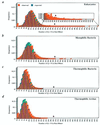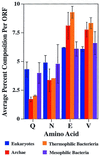A census of glutamine/asparagine-rich regions: implications for their conserved function and the prediction of novel prions
- PMID: 11050225
- PMCID: PMC17268
- DOI: 10.1073/pnas.97.22.11910
A census of glutamine/asparagine-rich regions: implications for their conserved function and the prediction of novel prions
Abstract
Glutamine/asparagine (Q/N)-rich domains have a high propensity to form self-propagating amyloid fibrils. This phenomenon underlies both prion-based inheritance in yeast and aggregation of a number of proteins involved in human neurodegenerative diseases. To examine the prevalence of this phenomenon, complete proteomic sequences of 31 organisms and several incomplete proteomic sequences were examined for Q/N-rich regions. We found that Q/N-rich regions are essentially absent from the thermophilic bacterial and archaeal proteomes. Moreover, the average Q/N content of the proteins in these organisms is markedly lower than in mesophilic bacteria and eukaryotes. Mesophilic bacterial proteomes contain a small number (0-4) of proteins with Q/N-rich regions. Remarkably, Q/N-rich domains are found in a much larger number of eukaryotic proteins (107-472 per proteome) with diverse biochemical functions. Analyses of these regions argue they have been evolutionarily selected perhaps as modular "polar zipper" protein-protein interaction domains. These data also provide a large pool of potential novel prion-forming proteins, two of which have recently been shown to behave as prions in yeast, thus suggesting that aggregation or prion-like regulation of protein function may be a normal regulatory process for many eukaryotic proteins with a wide variety of functions.
Figures



References
Publication types
MeSH terms
Substances
LinkOut - more resources
Full Text Sources
Other Literature Sources
Molecular Biology Databases

